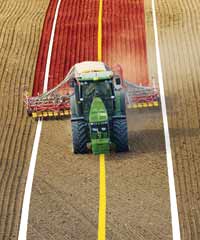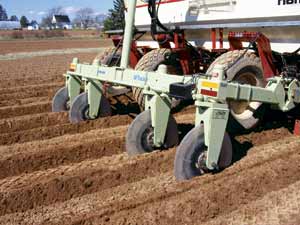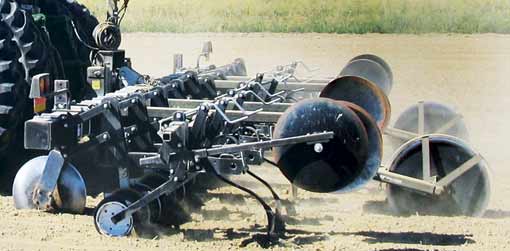Implement steer keeps trailed equipment on track

It’s all very well setting up virtual guidelines for a tractor’s visual guidance or automatic steering system to follow, but what if the implement being used doesn’t run true?
After all, a large part of the justification for autosteer is its ability to maximise implement output by minimising overlaps and allowing accurate work to continue at night. With ultra-accurate (±2cm) RTK system accuracy measured in the low centimetres, equipment that runs off-centre creates a headache.
“Once you’ve got a highly accurate RTK guidance system on the tractor, you come to realise how poorly a lot of implements follow, even on flat ground,” says Paul Cripsey of Bedfordshire grower FB Parrish & Sons. “We’ve started looking for some sort of steering correction for the implement because you can’t always compensate through the tractor’s steering.”
Speaking at a precision farming workshop organised by CTF Europe, an independent body that helps growers adopt a “controlled traffic” approach to field operations, Mr Cripsey cited difficulties keeping equipment on track when preparing land for potatoes and when planting onions.
With the latter, auto-steering achieves tight bed spacing but if things go out of true the tractor’s front wheels can end up running over a row trying to compensate.
Crop production consultant Hans-Henrik Pedersen of the AgroTech institute in Denmark specialises in GPS auto-steering and identifies two common causes of implement misalignment.
“For most growers, this problem relates to gravity pulling an implement downhill as it works across a slope,” he says. “This can be corrected using ‘passive’ implement steering, where you have a receiver on the implement to help control the tractor’s steering.”
Among the systems commercially available are Trimble’s TrueGuide and the John Deere iGuide system, both of which provide “passive” steering correction to keep heavy cultivation and seeding implements on track as they traverse hills and hollows.

GPS-steered guide discs on a potato planter in the US.
In both cases, these add-ons use the existing terminal of the tractor’s auto-steering system with a receiver mounted on the implement. Extra software calculates the steering inputs needed to offset the tractor uphill so that the implement follows the correct path to neatly butt up to the previous pass, with the overlap pre-set by the operator and no gaps.
It’s a step beyond the implement compensation feature that most auto-steering systems now have and which take into account the way a trailed implement cuts corners. They work by calculating the implement’s path from the position of the drawbar pivot and working elements – such as the coulters on a drill – relative to the receiver to cause the tractor to steer a little wider through a curve than it would otherwise.
With TrueGuide and iGuide, the receiver on the implement provides the main guide reference, with RTK signal correction giving ?±2cm accuracy. The tractor then compensates for implement crabbing on slopes, as well as accurately compensating through curves based on the actual path of the implement.
Suppliers say the technology brings to undulating and hilly ground all the benefits of accurate bout matching and tramline positioning that are easily achieved on level fields.
“However, the ‘passive’ steering approach may not be enough for a wide implement that tends to pull to one side or the other inconsistently,” Hans Henrik Pedersen points out. “And the level of consistent accuracy will not be enough in situations where you want the implement to consistently follow a very precise path.”
For those situations, some form of steering mechanism on the implement itself is the answer and one that growers in the USA are using to get pin-point accuracy with wide maize drills. It is also used on wide-spaced no-till seeders to place seed between the previous crop’s stubble rows – a technique that Väderstad’s Canadian partner, Seed Hawk, achieves using sensor-regulated offset control.
This level of implement control accuracy has other potential uses, he suggests. Such as strip tilling and placement of slurry and/or fertiliser along crop rows before they are sown – an approach that lends itself to a controlled traffic situation using the same wheel ways year after year.
WHAT EQUIPMENT IS OUT THERE?
Trimble
Trimble says its AgGPS TrueTracker package is designed to handle a number of different implement steering solutions, including on-the-move hydraulic drawbar adjustment, steerable implement support wheels and rudder discs, as well as side-shift and yaw adjustment on mounted equipment.
As well as the implement-mounted antenna, the system includes the NavController II controller with terrain correction to compensate for the antenna’s offset position caused when the implement is working across a significant incline.
Autofarm
The AutoFarm AFTracker is a so-called rudder system that attaches a set of large discs to the back of the implement. The discs are mounted on individual pivoting stub axles connected by a steering arm to a cylinder operated by the tractor’s hydraulics.
An antenna mounted on the implement feeds position signals to the RTK autosteer system that operates both the implement and tractor steering systems.
Orthman
Disc-steer manufacturer Orthman Agricultural makes its Tracker IV implement guidance equipment with just two discs for small implements and up to six discs for the biggest single row planters used in the US where the company is based.
In standard form, it uses physical probes to follow marker disc lines and a sensor on the steering mechanism to determine the angle of the discs so that any deviation from the required path can be corrected.
But it can also be used with GPS to provide electronically-controlled steering and Trimble plans to demonstrate the concept at this year’s Cereals Event.
Sunco

Sunco Acura Trak operates with a GPS antenna on the frame and stabilising discs on the back of the implement.
Sunco’s Acura Trak is designed to keep mounted implements on the correct heading regardless of side slopes or tractor movement.
It does so using an assembly of hydraulically actuated cranks positioned between the tractor’s lift arms and the implement. The crank arms effectively lengthen and shorten the tractor’s three-point linkage when sensors detect a change of angle between the power unit and the implement.

